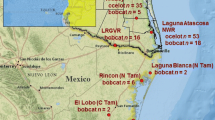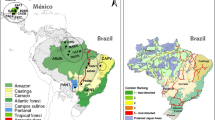Abstract
The effects of habitat loss and fragmentation on the genetic structure and variability of wild populations have received wide empirical support and theoretical formalization. By contrast, the effects of habitat quality seem largely underinvestigated, partly due to technical difficulties in properly assessing habitat quality. In this study, we combine geographic information system (GIS)-based habitat-quality modelling with a landscape genetics approach based on mitochondrial DNA markers to evaluate the possible influence of habitat quality on the levels and distribution of genetic diversity in a range of natural populations (n = 15) of Otis tarda throughout Spain. Ninety-three percent of the population represented by our countrywide sample lives in good-quality habitats, while 4.5% and 2.5% occur respectively in intermediate and poor habitats. Habitat quality was highly correlated with patch size, population size and population density, indicating the reliability and predictive power of the habitat suitability model. Genetic diversity was significantly correlated with habitat quality, size and density of the population, but not with patch size. Three of a total of 20 existing matrilineages from the species’ current genetic pool are restricted to poor-quality habitats. This study therefore highlights the importance of considering both population genetics and habitat quality in a species of high conservation priority.



Similar content being viewed by others
References
Alonso JC, Alonso JA (1996) The great bustard Otis tarda in Spain: present status, recent trends and an evaluation of earlier censuses. Biol Conserv 77:79–86
Alonso JC, Palacín C, Martín CA (2003) Status and recent trends of the great bustard (Otis tarda) population in the Iberian peninsula. Biol Conserv 110:185–195
Alonso JC, Martín CA, Alonso JA, Palacín C, Magana M, Lane SJ (2004) Distribution dynamics of a great bustard metapopulation throughout a decade: influence of conspecific attraction and recruitment. Biodiv Conserv 13:1659–1674
Alonso JC, Martín CA, Palacín C, Martín B, Magaña M (2005) The great bustard Otis tarda in Andalucía, southern Spain: status, distribution and trends. Ardeola 52:67–78
Alonso JC, Martín CA, Alonso JA, Palacín C, Magana M, Lieckfeldt D, Pitra C (2009) Genetic diversity of the great bustard in Iberia and Morocco: risks from current population fragmentation. Conserv Genet 10:379–390
Angers B, Magnan P, Plante M, Bernatchez L (1999) Canonical correspondence analysis for estimating spatial and environmental effects on microsatellite gene diversity in brook charr (Salvelinus fontinalis). Mol Ecol 8:1043–1053
Brotons LL, Thuiller W, Araújo MB, Hirzel AH (2004) Presence–absence versus presence-only modelling methods for predicting bird habitat suitability. Ecography 27:437–448
Costello AB, Down TE, Pollard SM, Pacas CJ, Taylor EB (2003) The influence of history and contemporary stream hydrology on the evolution of genetic diversity within species: an examination of microsatellite DNA variation in bull trout, Salvelinus confluentus (Pisces: Salmonidae). Evolution 57:328–344
Eastman JR (2000) Idrisi for Windows. User’s guide, Version 32. Clark Labs, Clark University, Worcester, USA
Elith J et al (2006) Novel methods improve prediction of species’ distributions from occurrence data. Ecography 29:129–151
Frankham R (1995) Inbreeding and conservation: a threshold effect. Conserv Biol 9:792–799
Frankham R (1996) Relationship of genetic variation to population size in wildlife. Conserv Biol 10:1500–1508
Franklin J, Miller JA (2009) Map** species distributions. Cambridge University Press, Cambridge
Fulgione D, Maselli V, Pavarese G, Rippa D, Rastogi RK (2009) Landscape fragmentation and habitat suitability in endangered Italian hare (Lepus corsicanus) and European hare (Lepus europaeus) populations. Eur J Wildl Res 55:385–396
García J, Suárez-Seoane S, Miguélez D, Osborne PE, Zumalacárregui C (2007) Spatial analysis of the habitat quality in a fragmented population of little bustard. Implications for conservation. Biol Conserv 137:45–56
Guisan A, Zimmermann NE (2000) Predictive habitat distribution models in ecology. Ecol Modell 135:147–186
Guisan A, Edwards TC, Hastie T (2002) Generalized linear and generalized additive models in studies of species distributions: setting the scene. Ecol Modell 157:89–100
Johnson MD (2007) Measuring habitat quality: a review. Condor 109:489–504
Lane SJ, Alonso JC (2001) Status and extinction probabilities of great bustard (Otis tarda) in Andalusia, southern Spain. Biodiv Conserv 10:893–910
Lane SJ, Alonso JC, Martín CA (2001) Habitat preferences of great bustard Otis tarda flocks in the arable steppes of central Spain: are potentially suitable areas unoccupied? J Appl Ecol 38:193–203
Lehmann A, Leathwick JR, Overton JMcC (2003) GRASP v.2.5 User’s manual. Landcare Research, Hamilton, New Zealand
Martín CA, Alonso JC, Alonso JA, Pitra C, Lieckfeldt D (2002) Great bustard population structure in central Spain: concordant results from genetic analysis and dispersal study. Proc R Soc B 269:119–125
Meynard CN, Quinn JF (2007) Predicting species distributions: a critical comparison of the most common statistical models using artificial species. J Biogeogr 34:1455–1469
Montgomery ME, Woodworth LM, Nurthen RK et al (2000) Relationships between population size and loss of genetic diversity: comparisons of experimental results with theoretical predictions. Conserv Genet 1:33–43
Moritz C (1994) Defining “Evolutionarily Significant Units” for conservation. Trends Ecol Evol 9:373–375
Nei M (1978) Estimation of average heterozygosity and genetic distance from a small number of individuals. Genetics 89:583–590
Osborne PE, Alonso JC, Bryant RG (2001) Modelling landscape-scale habitat use using GIS and remote sensing: a case study with great bustards. J Appl Ecol 38:458–471
Palacín C, Alonso JC (2008) An updated estimate of the world status and population trends of the Great Bustard Otis tarda. Ardeola 55:13–25
Pearce JL, Boyce MS (2006) Modelling distribution and abundance with presence-only data. J Appl Ecol 43:405–412
Pearce JL, Ferrier S (2000) Evaluating the predictive performance of habitat models developed using logistic regression. Ecol Modell 133:225–245
Posada D, Crandall KA (1998) Modeltest: testing the model of DNA substitution. Bioinformatics 14:817–818
Pinto M, Rocha P, Moreira F (2005) Long-term trends in great bustard (Otis tarda) populations in Portugal suggest concentration in single high quality area. Biol Conserv 124:415–423
Pitra C, Lieckfeldt D, Alonso JC (2000) Population subdivision in Europe’s great bustard inferred from mitochondrial and nuclear DNA sequence variation. Mol Ecol 9:1165–1170
Pitra C, Watzke H, Lieckfeldt D, Litzbarski H (2007) Conservation genetics of the great bustard in the Ponto-Caspian steppes (Ukraine and the lower Volga basin). Bustard Stud 6:99–110
Rozas J, Rozas R (1997) DnaSP, Version 2.0: a novel software package for extensive molecular population genetics analysis. CABIOS 13:307–311
Sanger F, Nicklen S, Coulson AR (1977) DNA sequencing with chain-terminating inhibitors. Proc Natl Acad Sci USA 74:5463–5467
Suárez-Seoane S, Osborne PE, Alonso JC (2002) Large-scale habitat selection by agricultural steppe birds in Spain: identifying species–habitat responses using generalized additive models. J Appl Ecol 39:755–771
U.S. Fish and Wildlife Service (1980) Habitat evaluation procedures (HEP). U.S Department of Interior Fish and Wildlife Service, Division Ecological Services Manual 102, Washington, D.C., USA
U.S. Fish and Wildlife Service (1981) Standards for the development of habitat suitability index models for use in the habitat evaluation procedure. U.S. Department of Interior Fish and Wildlife Service, Division Ecological Services Manual 103, Washington, D.C., USA
Van der Lee GEM, Van der Molen DT, Van den Boogaard HFP, Van der Klis H (2006) Uncertainty analysis of a spatial habitat suitability model and implications for ecological management of water bodies. Landscape Ecol 21:1019–1032
Venables WN, Ripley BD (1999) Modern applied statistics with S-Plus. Springer, New York
Vergeer P, Rengelink R, Copal A, Ouborg NJ (2003) The interacting effects of genetic variation, habitat quality and population size on performance of Succisa pratensis. J Ecol 91:18–26
Wood SN (2006) Generalized additive models. An introduction with R. Chapman & Hall/CRC, Boca Raton
Acknowledgments
We thank Javier Alonso, Carlos Palacín, Marina Magaña and Beatriz Martín for collaborating during fieldwork. Additional help was provided by Manuel Morales and Enrique Martín. We also thank Anke Schmidt and Dietmar Lieckfeldt for technical assistance, and P.E. Osborne for his participation in building the habitat suitability model. We also greatly appreciate the valuable comments from the editor and two anonymous reviewers. The study was financed by the Dirección General de investigación (projects PB94-0068, PB97-1252, BOS2002-01543 and CGL2008-02567).
Author information
Authors and Affiliations
Corresponding author
Additional information
Communicated by: C. Gortázar
Rights and permissions
About this article
Cite this article
Pitra, C., Suárez-Seoane, S., Martín, C.A. et al. Linking habitat quality with genetic diversity: a lesson from great bustards in Spain. Eur J Wildl Res 57, 411–419 (2011). https://doi.org/10.1007/s10344-010-0447-0
Received:
Revised:
Accepted:
Published:
Issue Date:
DOI: https://doi.org/10.1007/s10344-010-0447-0




